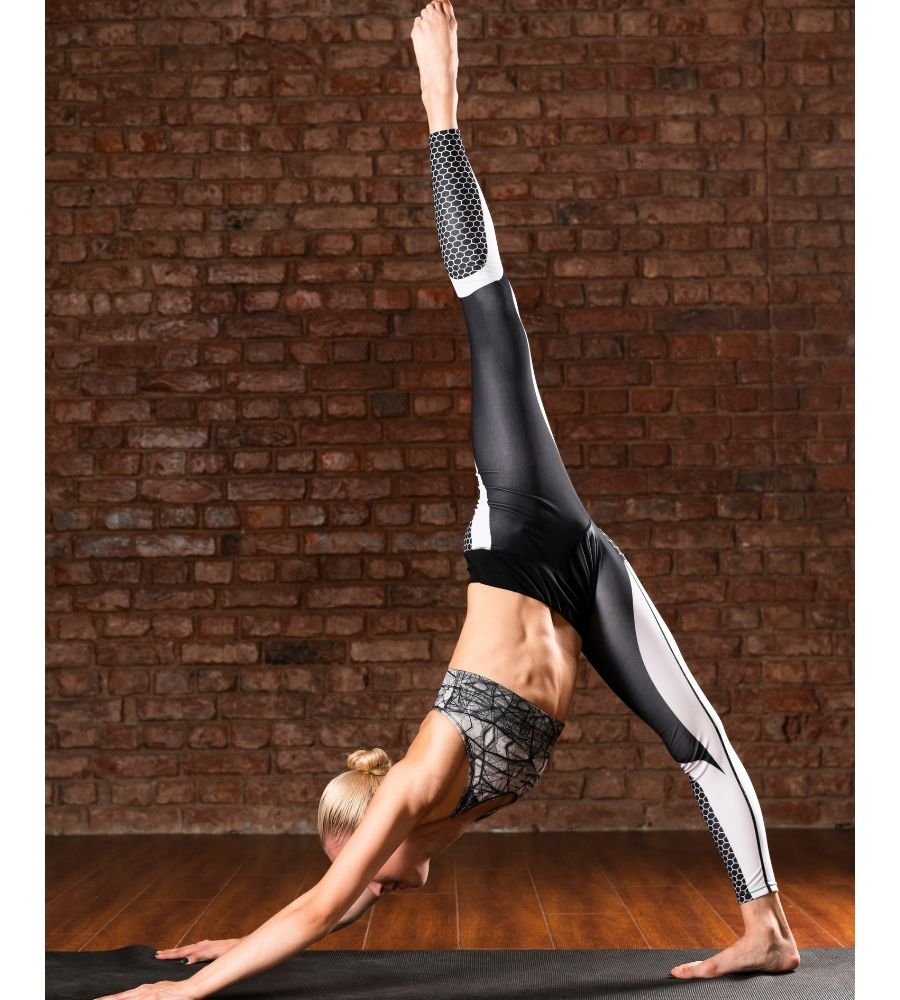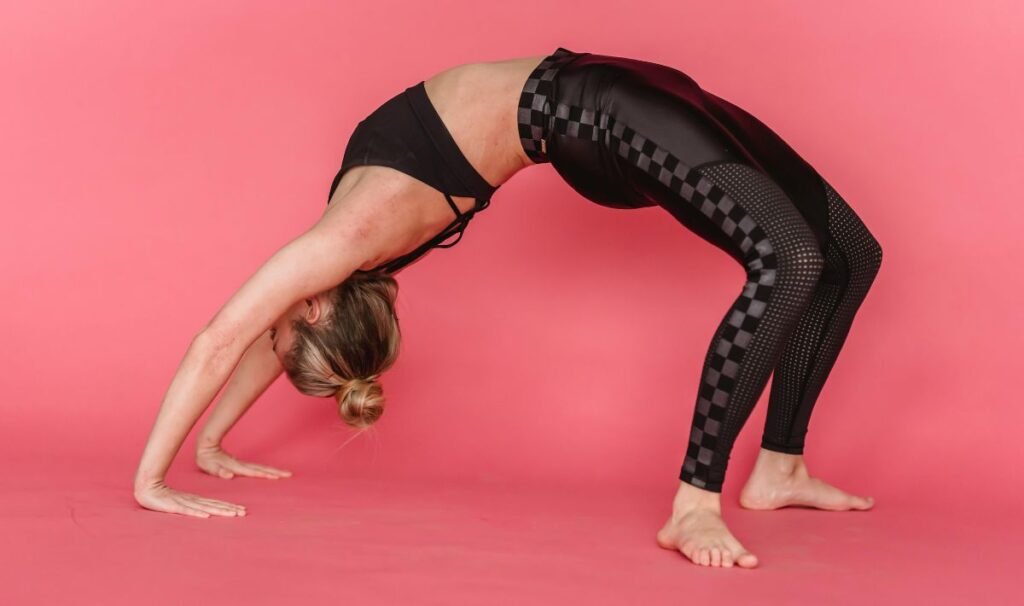Introduction
The Standing Split pose, or Urdhva Prasarita Eka Padasana in Sanskrit, is an empowering and transformative yoga pose that challenges both flexibility and balance. This invigorating posture stretches the hamstrings, strengthens the legs, and helps open up the hips—all while requiring a mindful balance that engages the core. While it might seem intimidating, with the right guidance and steady practice, anyone can work towards mastering this pose. Whether you’re looking to improve your split yoga practice, boost your mental focus, or simply enjoy the benefits of a powerful standing balance, the Standing Split can be a valuable addition to your yoga routine.
This guide will cover everything you need to know about Standing Split, from its benefits to step-by-step instructions and useful variations for all levels. By the end of this article, you’ll have the tools to practice this pose safely and effectively.
What is Standing Split (Urdhva Prasarita Eka Padasana)?
Standing Split, or Urdhva Prasarita Eka Padasana, is a balancing yoga pose where one leg extends vertically into the air while the other remains grounded, creating a deep hamstring stretch. It’s often practiced towards the end of a yoga sequence as it prepares the body for cooling down and stretching.
Key Elements of the Standing Split Pose
- Stability and Balance: The grounded leg provides a foundation while the upper body leans forward and one leg extends upward, requiring intense balance.
- Hamstring Stretch: This pose deeply stretches the hamstrings, which is beneficial for both flexibility and mobility.
- Core Engagement: Engaging the core helps stabilize the body, making it a powerful pose for building strength in the midsection.
Benefits of Practicing Standing Split
Practicing the Standing Split pose regularly can provide a range of physical and mental benefits. Here’s a breakdown of how this pose can improve your overall well-being:
`1 . Increased Flexibility
- Standing Split is an excellent way to improve hamstring flexibility. For those aiming to work towards a full split or want to open up the lower body, this pose helps lengthen the muscles along the back of the leg.
2. Improved Balance and Stability
- Standing Split is a balance-intensive pose that engages your core and requires you to stabilize on one leg, which improves overall balance and enhances stability.
3. Enhanced Mental Focus
- The focus required to maintain balance in this pose can help calm the mind and improve concentration. Practicing this asana regularly can enhance mental clarity and mindfulness.
4. Strengthened Legs and Glutes
- This pose engages both the grounded leg and the lifted leg, which strengthens the quadriceps, calves, and glutes. This makes Standing Split an excellent pose for developing lower body strength.
5. Opening of the Hips
- For those with tight hip flexors, Standing Split helps open and stretch the hip area, promoting better mobility and reduced tension in the lower body.
6. A Full-Body Stretch
- This pose doesn’t just work the legs but also stretches the spine and shoulders as you fold forward, making it a beneficial posture for overall flexibility.
Readmore: Wild Thing Pose Guide (Camatkarasana)
Readmore: Balancing Table Pose (Dandayamna Bharmanasana)
How to Perform the Standing Split Pose (Step-by-Step)
To ensure a safe and effective Standing Split pose, follow these step-by-step instructions:
Preparation
- Props: If you’re new to Standing Split, having yoga blocks nearby can provide support and stability.
- Warm-up: Before attempting this pose, warm up with poses like Forward Fold (Uttanasana), Downward Dog (Adho Mukha Svanasana), and Warrior I (Virabhadrasana I) to stretch and prepare your muscles.
Step-by-Step Guide
- Start in Mountain Pose (Tadasana)
- Begin by standing tall, grounding both feet into the mat. Engage your core and lengthen your spine.
- Transition into Forward Fold (Uttanasana)
- On an exhale, fold forward at the hips, keeping a slight bend in your knees if needed. Allow your fingertips to reach down to the mat or to yoga blocks for support.
- Shift Your Weight onto One Leg
- Pick a leg to work with first, such as your left leg. Shift your weight onto that leg while keeping your core engaged and your gaze focused on a point for balance.
- Lift the Opposite Leg
- Inhale as you lift your right leg towards the sky. Extend the leg as straight as possible, pointing your toes or flexing the foot, whichever feels more stable.
- Square the Hips and Extend
- Try to square your hips as much as possible so that the lifted leg aligns with your body rather than opening outward. Extend the leg high without straining.
- Deepen the Fold
- If you feel stable, bring your hands closer to your standing leg, or even grab your ankle to deepen the stretch.
- Hold and Breathe
- Hold the pose for 5–10 breaths, breathing deeply. Keep your focus on balance and form.
- Release and Switch Sides
- Exhale and slowly lower your lifted leg back to the mat. Repeat on the other side for a balanced practice.
Tips for Mastering Standing Split
- Use Props: Yoga blocks are helpful if you can’t reach the floor comfortably. Place them under your hands to support yourself as you work on balance and flexibility.
- Focus on Form: Prioritize form over height. It’s better to keep your hips squared and lift the leg only as high as your body allows without twisting.
- Engage the Core: Engaging the core will provide stability and help you stay balanced, especially when lifting your leg higher.
- Practice Patience: Flexibility and balance improve over time, so approach this pose with patience, practicing consistently.
Readmore: Beginner’s Guide to Kundalini Yoga
Readmore: Yoga & Indian Culture
Variations of Standing Split
As you progress in your Standing Split journey, try these variations to explore different aspects of the pose:
1 . Standing Split with Wall Support
- Stand facing a wall and place your hands on it for support. Lift one leg into the air, using the wall for balance. This is especially helpful for beginners working on stability.
2. Standing Split with Hands at Ankle
- Once comfortable in the basic pose, reach down to grab the standing-leg ankle for a deeper fold. This variation challenges flexibility and balance even further.
3. Bound Standing Split (Hand to Foot)
- Advanced practitioners can reach one hand to grab the foot of the lifted leg, drawing it closer to the body to increase the stretch.
4. One-Handed Standing Split
- Place only one hand on the floor or a block, extending the other arm upward to increase the difficulty of the balance. This variation strengthens the core and challenges your balance.
5. Revolved Standing Split (Parivrtta Eka Pada Uttanasana)
- Twist the torso slightly and place one hand on the opposite leg’s side, deepening the stretch and adding a twist. This variation helps improve flexibility and adds a spinal twist to the pose.
Mistakes to Avoid
- Not Keeping the Hips Square
- Allowing the hip of the lifted leg to open can disrupt the pose’s alignment. Keep your hips squared to the ground to prevent twisting and maintain stability.
- Forcing the Lift
- Avoid overextending your lifted leg if it compromises your form. Go only as high as you can maintain control and stability.
- Losing Core Engagement
- Without core engagement, balance becomes more challenging. Keep your core activated to support the standing leg.
- Locking the Knee of the Standing Leg
- Avoid locking the standing leg’s knee to prevent straining the joint. Keep a gentle bend if needed for better support.
Final Thoughts on Standing Split (Urdhva Prasarita Eka Padasana)
Standing Split is a rewarding pose that offers numerous benefits for flexibility, strength, and mental focus. Whether you’re a beginner or an advanced practitioner, this pose has plenty of variations and modifications to suit your practice. As you work towards your Standing Split, remember that consistency is key, and balance will come with time and patience.
Incorporate Standing Split into your routine and enjoy the journey toward greater flexibility, balance, and mindfulness. The journey itself is as valuable as reaching the perfect split—embrace each step with awareness and self-compassion.
Readmore: Twisted Monkey Pose: Crooked Monkey Yoga
Readmore: Elephant Trunk Pose (Eka Hasta Bhujasana)
FAQs about Standing Split Pose
How often should I practice Standing Split?
Practicing Standing Split a few times a week can be beneficial. Incorporating it into your yoga flow after warming up will yield the best results.
Is Standing Split safe for beginners?
Yes, with modifications like using a wall or blocks, beginners can safely work on their Standing Split. Avoid pushing yourself too far too soon to prevent injury.
What should I focus on while holding the pose?
Concentrate on balance, alignment, and breathing. These elements will help you progress safely and effectively in your practice.
What if I have tight hamstrings?
Use a slight bend in the standing leg and don’t worry about lifting the opposite leg too high. With time and practice, your flexibility will improve.

Sonu is a passionate yoga teacher with over 6+ years of experience helping individuals find balance, strength, and inner peace through the transformative power of yoga. As the creator of Pure Yoga Vibes, Sonu shares expert insights, inspiring practices, and a wealth of knowledge to support your wellness journey. Dedicated to creating a space for growth and mindfulness, Sonu’s mission is to make yoga accessible and enjoyable for everyone. For inquiries or collaborations, feel free to reach out at contact@pureyogavibes.com.



